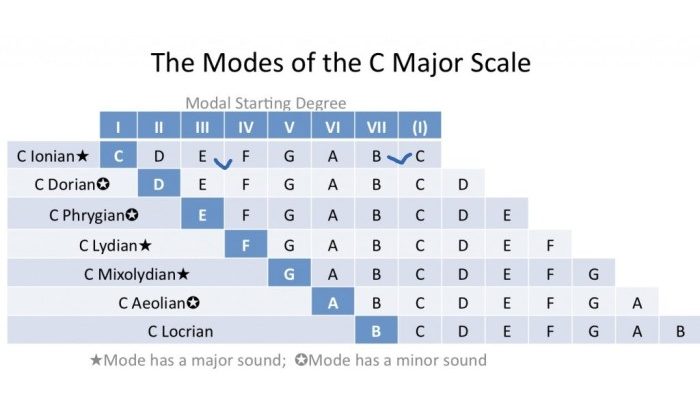Allegory chart for animal farm – Embark on an allegorical journey with the Animal Farm allegory chart, a comprehensive guide that unveils the hidden meanings behind George Orwell’s timeless masterpiece. From the symbolic animals to the critique of totalitarianism, this chart provides a deeper understanding of the novel’s profound message.
Delve into the allegorical themes, historical context, and literary devices that Orwell masterfully employs to convey his critique of political tyranny. Explore the symbolism of the farm and its inhabitants, tracing the evolution of the revolution and the role of language and propaganda in shaping the animals’ perceptions.
Allegorical Character Chart
Animal Farm by George Orwell is a political allegory, a story that uses animal characters to represent human beings and institutions. The following table provides an allegorical character chart, identifying the animal characters, their human counterparts, the symbolism they represent, and their significance in the story.
This chart helps us understand the deeper meaning behind the characters and events in Animal Farm, highlighting the author’s critique of totalitarianism and the dangers of unchecked power.
Allegorical Character Chart
| Animal | Human Counterpart | Symbolism | Significance |
|---|---|---|---|
| Mr. Jones | Tsar Nicholas II | Ineffective and oppressive ruler | Represents the old regime, overthrown by the animals |
| Napoleon | Joseph Stalin | Ruthless and power-hungry dictator | Seizes control of the farm and establishes a totalitarian regime |
| Snowball | Leon Trotsky | Idealistic and intelligent leader | Exiled by Napoleon, representing the suppression of dissent |
| Squealer | Propaganda minister | Manipulates language to justify Napoleon’s actions | Represents the use of propaganda to control the masses |
| Boxer | Working class | Strong and hardworking, but exploited by the pigs | Represents the sacrifices and suffering of the common people |
| Benjamin | Cynical and apathetic observer | Recognizes the futility of rebellion | Represents the disillusionment and apathy that can arise under oppressive regimes |
Major Allegorical Themes
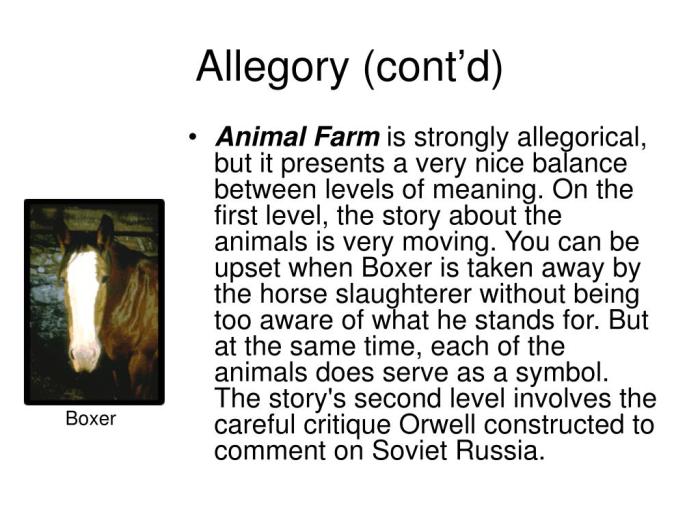
Animal Farmis a classic allegory, using animal characters to represent human society and political events. The novel explores several major allegorical themes, including:
- The dangers of totalitarianism: The novel shows how a totalitarian government can use propaganda, fear, and violence to control its citizens.
- The importance of equality: The animals initially rebel against the humans in order to create a more just and equitable society, but they eventually end up creating a new hierarchy that is just as oppressive as the old one.
- The futility of revolution: The novel suggests that revolution is often doomed to failure, as the new government is likely to become just as corrupt and oppressive as the old one.
Historical and Political Context
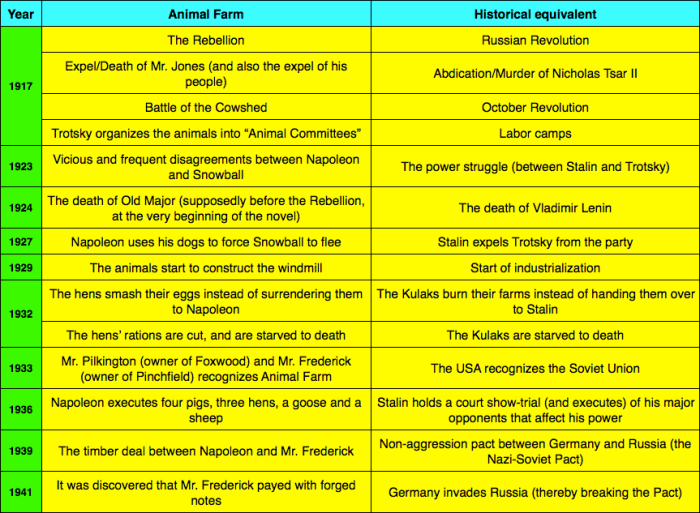
Animal Farm was heavily influenced by the historical and political events of Orwell’s time. The allegory reflects the rise of totalitarian regimes, particularly the Soviet Union under Joseph Stalin.
While the allegory chart for Animal Farm provides valuable insights into the novel’s symbolism, it’s also essential to explore other historical events that share similar themes. One such event is Paul Revere’s ride, which played a crucial role in the American Revolution.
Learn more about Paul Revere’s ride to gain a deeper understanding of how allegory can be used to convey important historical narratives, just like it does in Animal Farm.
Totalitarianism
- Orwell witnessed the rise of fascist and communist dictatorships, which used propaganda and censorship to control their populations.
- Animal Farm depicts how a revolution led by noble ideals can be corrupted by a single, tyrannical leader (Napoleon) who exploits the animals for his own gain.
Russian Revolution
- The allegory parallels the Russian Revolution, where the animals represent the Russian people, and the pigs represent the communist leaders.
- The pigs’ initial idealism is replaced by greed and power-hunger, mirroring the corruption that plagued the Soviet regime.
Propaganda and Censorship
- Orwell’s experiences with propaganda and censorship in the Spanish Civil War influenced the allegory.
- Squealer, the pig who manipulates the animals’ perceptions, represents the role of propaganda in maintaining control.
Animal Farm as a Critique of Totalitarianism
Animal Farm is a scathing critique of totalitarian regimes, particularly the Soviet Union under Joseph Stalin. The novel exposes the dangers of unchecked power and the corrupting influence of absolute authority.
Characteristics and Practices of Totalitarianism Satirized in Animal Farm
Animal Farm satirizes several key characteristics and practices of totalitarian regimes, including:
- Censorship and Propaganda:The pigs control the flow of information, suppressing dissent and rewriting history to suit their agenda.
- Personality Cult:Napoleon becomes the object of a personality cult, with his image and slogans plastered everywhere.
- Terror and Intimidation:The pigs use fear and violence to maintain control, as exemplified by the executions of Snowball and other dissidents.
- Control of the Economy:The pigs exploit the other animals, taking the best for themselves and leaving the rest to starve.
- Cult of Ignorance:The pigs suppress education and critical thinking, keeping the animals in a state of ignorance.
Symbolism of the Farm and the Animals: Allegory Chart For Animal Farm
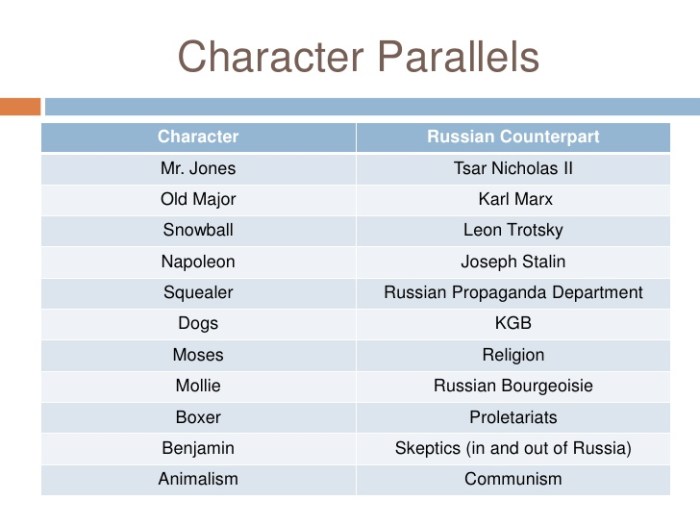
The farm in Animal Farmsymbolizes the Russian Empire, while the animals represent different social classes and political figures involved in the Russian Revolution.
The Farm
- Manor Farm:Represents the Russian Empire under the rule of Tsar Nicholas II.
- The windmill:Symbolizes the industrialization efforts of the Soviet Union.
- The farmhouse:Represents the Kremlin, the seat of Soviet power.
The Animals
- Pigs:Represent the communist leaders, particularly Joseph Stalin.
- Horses:Represent the working class.
- Dogs:Represent the secret police.
- Sheep:Represent the ignorant and easily manipulated masses.
- Donkeys:Represent the intellectuals who initially support the revolution but later become disillusioned.
These symbols contribute to the novel’s overall meaning by highlighting the parallels between the events in Animal Farmand the Russian Revolution. They also emphasize the dangers of totalitarianism and the importance of individual freedom and equality.
Literary Devices and Techniques
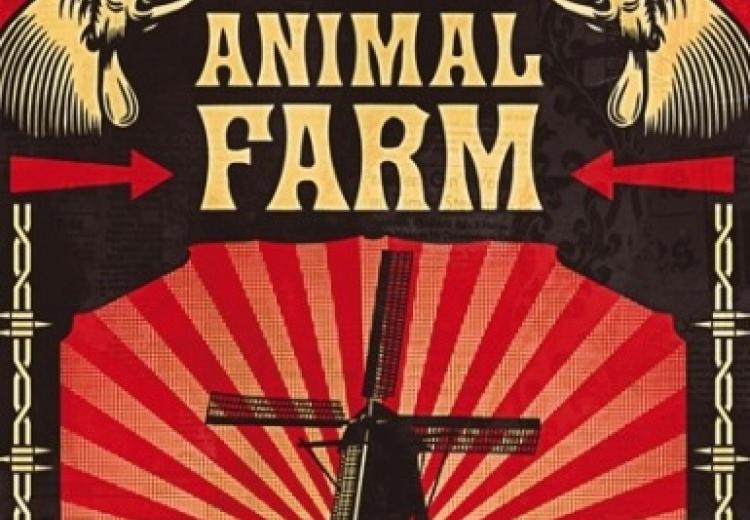
Orwell employs various literary devices and techniques in Animal Farm to enhance its allegorical message and make it more impactful.
One of the most notable devices is personification, where human characteristics are attributed to non-human entities. This technique allows Orwell to portray the animals as complex and relatable characters, making the allegory more accessible and engaging.
Use of Animal Archetypes
Orwell also uses animal archetypesto represent different human types. For instance, the pigs represent the ruling class, the dogs represent the secret police, and the sheep represent the masses. By using these archetypes, Orwell is able to convey complex political and social ideas in a simple and memorable way.
Satire and Humor
Satireand humorare also prevalent in Animal Farm. Orwell uses these techniques to expose the absurdity and hypocrisy of totalitarianism. By poking fun at the characters and their actions, Orwell makes the novel both entertaining and thought-provoking.
Allegory and Symbolism
The novel’s allegoricalnature is further enhanced by its use of symbolism. For example, the windmill represents industrialization, while the battle of the Cowshed symbolizes the Spanish Civil War. These symbols allow Orwell to explore complex themes and ideas in a subtle and evocative way.
Foreshadowing
Foreshadowingis another technique Orwell employs to create suspense and build tension. For instance, the pigs’ early tendency to alter the commandments foreshadows their eventual betrayal of the animals.
The Evolution of the Revolution
The Animal Farm revolution underwent a significant evolution, marked by key events and turning points that ultimately led to its failure.
Initial Uprising and Idealism
The revolution began with the animals’ shared desire for freedom and equality. They revolted against the oppressive human farmer, Mr. Jones, and established their own society based on the principles of Animalism.
Power Struggles and Division
However, as time passed, power struggles emerged among the animals. The pigs, led by Napoleon, gradually gained control and manipulated the rules to their advantage. This division undermined the unity and trust that had initially fueled the revolution.
The Rise of Napoleon’s Dictatorship
Napoleon’s cunning and ruthlessness allowed him to establish a dictatorship. He silenced dissent, rewrote history, and used fear and intimidation to maintain his power. The ideals of equality and freedom were gradually abandoned.
The Betrayal of the Revolution, Allegory chart for animal farm
The final blow to the revolution came when Napoleon allied himself with the humans. He adopted their practices and values, ultimately transforming the Animal Farm back into a human-run farm. The animals’ hopes and dreams were shattered.
Lessons from the Revolution’s Failure
The failure of the Animal Farm revolution highlights the dangers of power corrupts and the importance of vigilance in safeguarding ideals. It also demonstrates the need for unity and resistance against oppression.
The Role of Language and Propaganda
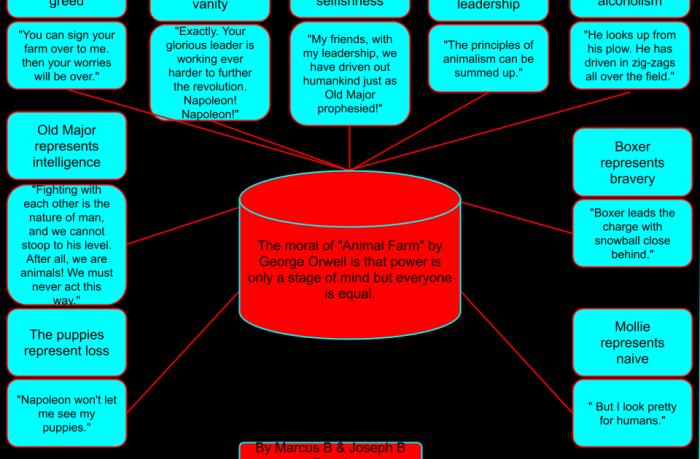
Language and propaganda play a pivotal role in Animal Farm, serving as tools to manipulate and control the animals. The pigs, who assume leadership after the rebellion, wield these elements to their advantage, distorting information and instilling fear and loyalty in the animal community.
One key propaganda technique employed is the use of slogans and maxims. The pigs introduce catchy phrases like “All animals are equal” and “Four legs good, two legs bad,” which become ingrained in the animals’ minds and shape their perceptions of the world.
These slogans serve to simplify complex ideas and create a sense of unity, while also suppressing critical thinking and dissent.
Censorship and Control of Information
The pigs also engage in censorship and control of information to maintain their power. They manipulate the animals’ access to knowledge by altering historical records and silencing dissenting voices. For example, they rewrite the Seven Commandments to justify their own actions and eliminate any evidence that contradicts their narrative.
Manipulation of Language
Moreover, the pigs manipulate language itself to suit their purposes. They introduce new words and redefine existing ones, creating a distorted reality that aligns with their agenda. For instance, the word “comrade” is initially used to promote unity among the animals, but it later becomes a tool for suppressing individuality and enforcing conformity.
Frequently Asked Questions
What is the significance of the animals in Animal Farm?
Each animal represents a specific group or individual within the Russian Revolution, embodying their characteristics and motivations.
How does the allegory chart help interpret the novel?
The chart provides a structured framework for understanding the allegorical meanings behind the characters, themes, and events in Animal Farm.

